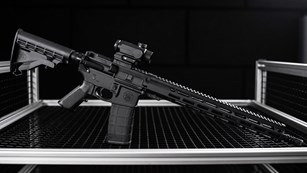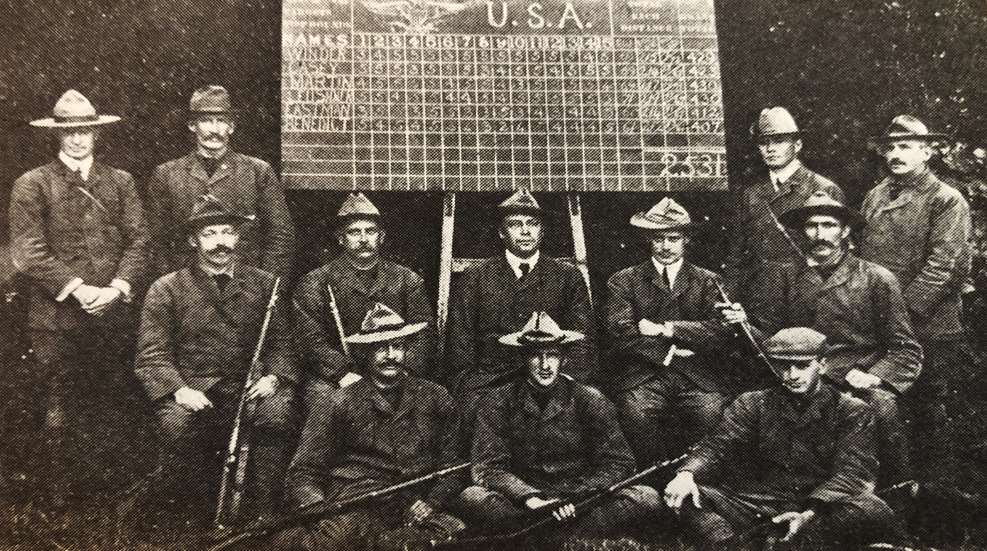
The below is an excerpt from the 1978 book, Olympic Shooting, written by Col. Jim Crossman and published by the NRA. Read Part 1 and Part 2.
1908—London: The U.S. Team Almost Missed The Games (Part 3)
By Colonel Jim Crossman
The novel quick-fire match was fired at 25 yards, using either the .22 or .297/.230 cartridge. The target was a three-quarter length silhouette figure, 4 inches high and 1½ inches wide. The target was exposed for 3 second intervals, with 5-second periods between exposures. The only United States entry in this match was Walter Winans, who did not do too well. United Kingdom shooters took the first six places in this event.
The 25-yard moving target match used the same silhouette target and permitted the same cartridges as the quick-fire event. The target ran across the shooter's front, covering a distance of 10 feet in 4 seconds. Again, the only U.S. entry was Winans, who ended up halfway down the result list, with seven U.K. shooters leading the way.
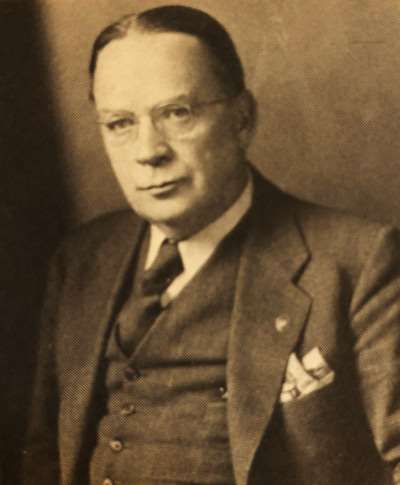
Although the Americans had—apparently—unlimited game and many chances to shoot deer, they did not seem to take to the running deer target shooting. Or perhaps with so much game, there was not much enthusiasm for shooting at inert targets. In any event, there was no U.S. entry for the team event. Fired on a deer-sized target at 110 yards with a 6-inch bullseye counting 4, a 12-inch inner counting 3 and an 18-inch magpie counting 2, the match permitted any rifle with fixed open sights and a 3-pound trigger pull. The deer ran across a 75-foot opening in about 4 seconds, and the shooter could not raise his rifle to his shoulder until the deer appeared from behind the end screens.
The individual single-shot match was won by O.G. Swahn, Sweden, with Capt. T.K. Ranken of the U.K. taking second and A.E. Rogers, U.K., third.
Winans was the sole U.S. entry and finished in seventh.
The individual double-shot match was fired under the same conditions, except that two shots were fired in each 4-second run of the deer. This was a new event, and where the single-shot or magazine rifle had been favored for the single-shot match, the double rifle proved its merit in the new match. Walter Winans used a double rifle with a high-velocity, light pointed bullet, which called for only a 16-inch lead on the moving deer. Winans tied Capt. Ranken in this event and beat him in the shoot-off to win the only individual American Olympic gold medal.
The American pistol shooters brought over .22 pistols with UMC long rifle smokeless cartridges for quiet days and .38 caliber revolvers with UMC special smokeless ammunition for bad weather. In the individual pistol match, Sayre used a .38 S&W revolver with a special barrel made by the famous Harry Pope. Axtell used a .38 S&W revolver, while Tayntor weighted his .22 S&W revolver with a Pope barrel by putting lead slugs under the barrel. Gorman also weighted his gun, a .22 S&W single-shot with special, large and heavy grips. The other U.S. shooters used their .22 S&W pistols and in the team match all shot the S&W .22 single-shot pistol.
Despite this choice of equipment the Americans found themselves considerably out-gunned by the foreign free pistols. With about the only restriction being that the gun must have open sights, many of the foreign guns had large, form-fitting grips, long barrels, fancy sights and featherlight trigger pulls. These guns were an entirely different class than the American pistols and revolvers, with their trigger pulls of 2 pounds or more.
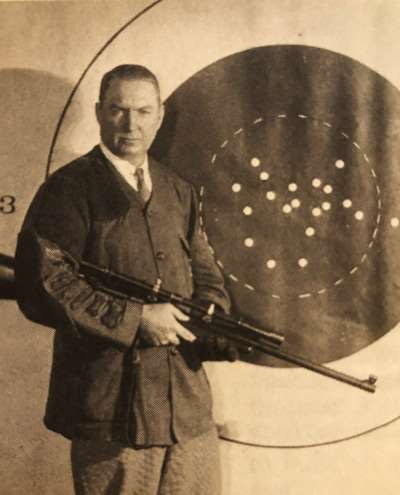
It was all the more bitter, therefore, when J.A. Gorman, the last shooter to finish the individual match, was declared to have shot a miss on one target. He protested that he had a double—2 shots through the same hole. The final ruling, however, gave him a miss instead of a nine and a score of 485, which dropped him down to the bronze medal. P. Van Asbrock, Belgium, won the gold with 490 and his teammate, R. Storms, won the silver with 487.
On the next day, Gorman got some satisfaction in the team match, where his score of 501 was by far the best score of the day and led the American pistol team to its Olympic championship. The Belgians' second-place 1863 was well behind the Americans' 1914 score, while the U.K. was third with 1817.
The International drew nine entries, but only eight teams showed up, thanks to Julius Caesar. Caesar had found existing calendars pretty much a mess and bearing little relation to actuality. He developed the calendar essentially as we use it today, with 12 months and with the year 365 days 6 hours in length. Unfortunately, this was a little long, and by the 16th century the Julian calendar had picked up about 10 days. To straighten things out, Pope Gregory XIII adopted a new calendar which dropped 10 days and made a change in the length of the year.
The Gregorian calendar was rapidly accepted in most Roman Catholic countries, but not until the mid-1700s in England and sometime after 1908 throughout Russia. The Russians, putting complete confidence in their Julian calendar, arrived at Bisley Camp for the Olympic shoot, only to find that the match, scheduled on the Gregorian calendar, was finished and everyone had gone home.
The American team looked natty as they marched out to the range on the first morning of the International. Their waterproof Norfolk-style Burberry jackets had "United States" embroidered in black on the right lapel and "Rifle Team" on the left lapel. The breeches were cut as riding trousers and were supplemented by strap puttees. Buckskin pads were sewn on the elbows of the olive green jacket. But the fine outfit was soon covered by yellow oil-skin trousers and raincoats in an attempt to keep dry on that cold, windy and rainy morning.
Under the conditions, it was nearly impossible to keep all 15 shots in the 6-inch bullseye at 200 yards. Casey was high man on the range with 74, while the Americans led at the end of the stage with 428, to Sweden's 423, U.K.'s 419 and Canada's 412. At the 500-yard range, the Swedes, shooting without slings and without windage adjustment on their sights, dropped behind the U.K., while the United States added a couple more points to their lead over the United Kingdom.
The 600-yad stage was fired late in the afternoon, with conditions even worse. Wind, rain and mist made shooting most unpleasant, but despite the conditions Winder scored a 73, while the low team score was 69. The British showed they knew how to cope with these Bisley conditions and topped the American score by one point—the only range at which they led.
At the end of the first day's shooting and halfway through the match, the Americans had first place by a slim, 10-point margin, 1291 to the U.K. 1281. Canada had moved into possession of third place, although well back with 1244.
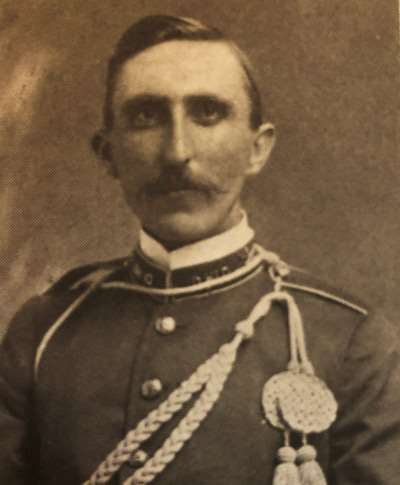
On the final day, the great Stickledown Range at Bisley Camp, with its targets at 800, 900 and 1,000 yards, lived up to its tough reputation. Lowering clouds, winds varying from 12 to 20 m.p.h., and an occasional flurry of rain were the best conditions the weatherman could give all day long. At the 800-yard distance the Americans had one 71 and five 73s, to add three points to their lead over the British. At the 900-yard stage the U.S. team picked up six more points, while at the final 1,000-yard stage Eastman and Benedict ran into some trouble, with scores of 60 and 61, but the British also had troubles and the U.S. team swamped them by 16 points!
A clay bird event was conducted as part of the 1908 Games, but all the satisfaction the Americans could get was that two shooters from neighboring Canada took the first two individual places, W.H. Ewing winning the gold and G. Beattie the silver, while Maunder (U.K.) and Metaxas (Greece) shot off a tie for third place. Another small crumb of comfort was the fact that Ewing shot an American-made Lefever shotgun, which fact was duly noted in Lefever advertisements. In the team match, the U.K. took first and Canada second place.
American clay bird shooting was quite different from the matches held at Uxendon for the 1908 Games. The clay bird event used a multiple-trap trench, much as is used for Olympic and international shooting today. Each competitor initially shot at 30 clay birds, and the lower half of the competitors were eliminated. After shooting another 20 birds, half the remaining shooters dropped out. The last stage included 20 more birds on the continuous fire system, plus 10 fired at unknown angles from any one of nine unknown traps. Ewing led at all three stages, finishing with 72x80 birds.
A few days later, the Queen presented the prizes. The huge throng in the stadium at Shepherd's Bush saw the American shooters receive 3 gold medals, 2 silver and 1 bronze. Sweden was in third place overall with 2 gold, 2 silver and 1 bronze, while the U.K. led the pack with 5 firsts, 7 seconds and 6 thirds.
The Americans, having pointed for the big rifle and pistol team matches, were delighted to have won both of them and figured any other awards were just so much to the good. And they did not do too badly, considering the tribulations in getting the team to England. Six Olympic medals—not bad for the year that almost wasn't.
The rifle team stopped over in London for three days before sailing home to a triumphal welcome. The team discovered that they had been robbed and, while concerned about the loss of some jewelry, the heartbreaker was to find that the team's Olympic gold medal was gone!
On receiving the news, Lord Desborough, head of the British Olympic Association, promptly provided the team with another medal. It was a proud and happy bunch of shooters, then, that steamed into New York harbor on that August day in 1908, to the sight of flags flying and the thunderous sound of the 35-gun salute. In addition, many of the individuals received much acclaim when they returned home. William Leushner, the high scorer on the team, was given a tremendous welcome by the people of Buffalo, with bands, a parade, fireworks, a banquet and—not the least—a purse of gold from the members of his regiment.
Other team members looked forward to equally enthusiastic homecomings, as they departed New York with the sound of that 35-gun salute still in their ears.
The 35 guns? The Mohawk fired in the team's honor one gun for every point by which they had beaten the British team.
Oh yes, and that signal "ZBH UXX" meant "Welcome Riflemen."
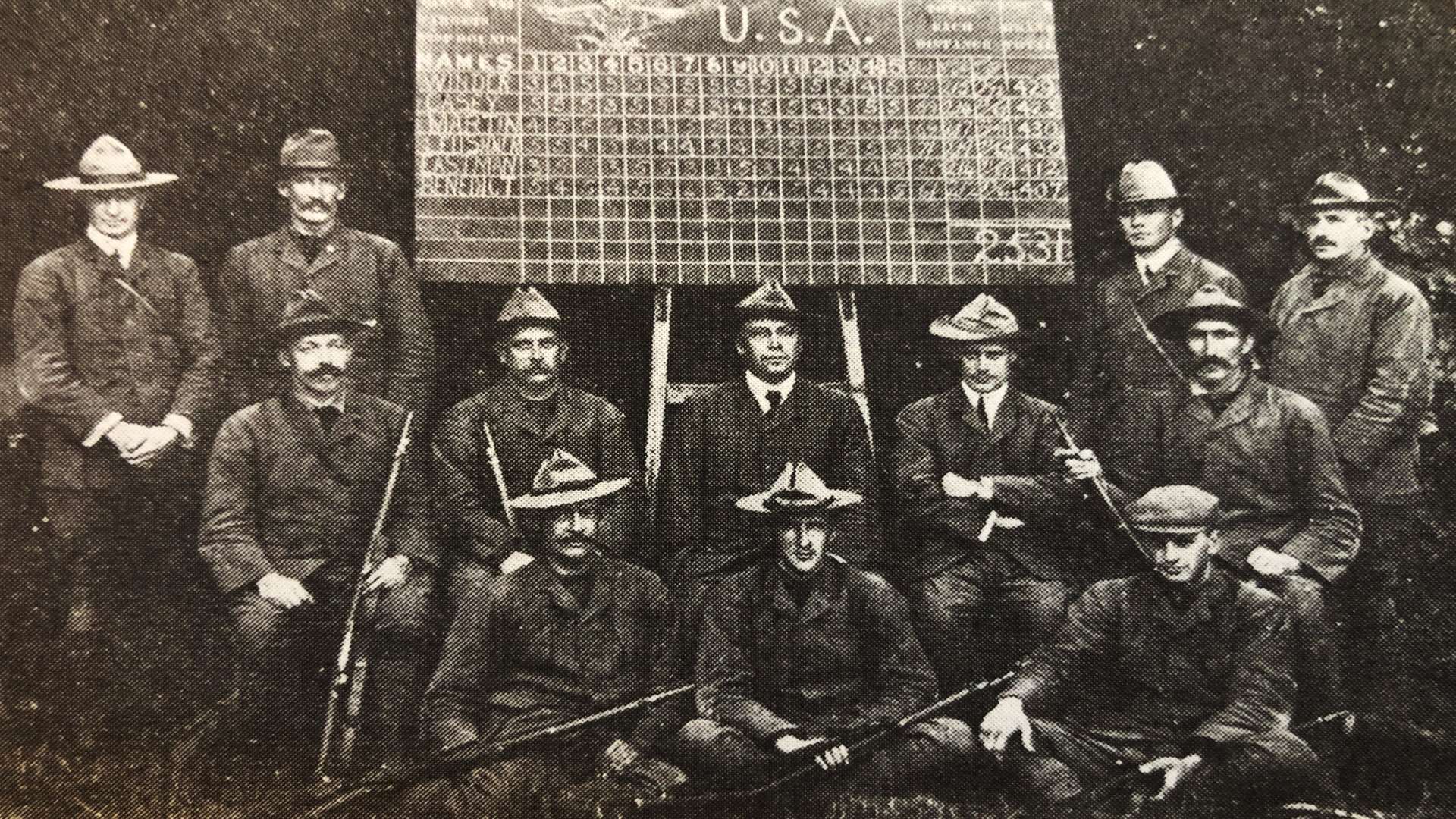
Photo: The Champion American Rifle Team, winners of the International Match in 1908 at the Olympic Games in London, England, and recipients of the gold medal, was comprised of the following shooters: Sgt. Wm. F. Leushner, Maj. Wm. B. Martin, Maj. Charles B. Winder, Capt. K.K.V. Casey, Cpl. Ivan L. Eastman and Capt. Charles S. Benedict.
See more: The Origin Of The Olympic Games











